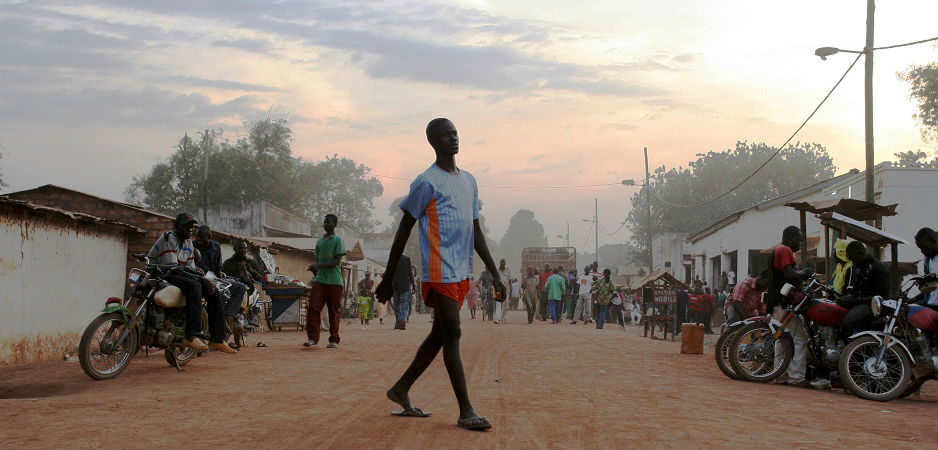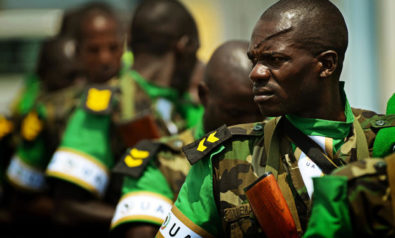Who will heal the wounds of vengeance and retribution in the Central African Republic?
On April 10, after months of discussion, negotiation and compromise, the United Nations Security Council authorized a 12,000-member peacekeeping operation for the Central African Republic (CAR). This is a country that had languished for decades in the shadows, until a coup d’état in March 2013 brought about such unprecedented levels of violence that the international community could no longer look the other way.
The peacekeeping operation, the UN Multidimensional Integrated Stabilization Mission in the CAR (MINUSCA), scheduled to be deployed in September, will replace French and European Union troops and the current African Union (AU) peacekeeping mission, known by its French acronym, MISCA. The latter mission was itself authorized by the UN on December 5, 2013, and has since been struggling to control the violence.
MINUSCA will be tasked with restoring security, disarming and demobilizing anti-Balaka militias and former Séléka rebels, and rebuilding the state in a nation that has effectively been without one for over a year. But the bigger, and more vital, task facing MINUSCA and Central African political and civil society leaders will be laying the necessary groundwork to bring justice, reconciliation and healing to a nation torn apart by enflamed ethno-religious divisions, and the unprecedented mass exodus of Muslims from the country.
Causes of the Conflict: The Roots Are Not Religious
Every day for the past ten years, I have received an email listing the reports relevant to the CAR. Since December 2012, when the Muslim-dominated armed opposition group, known as Séléka, began their march to power, I had grown accustomed to daily reports of violence and chaos, interspersed with humanitarian and political updates on the situation. In early September 2013, the town of Bouca, located in the northern Ouham province with a population of around 15,000 people, was attacked, first by anti-Balaka (Christian-dominated militia groups) and then by members of Séléka.
The numbers of those killed and injured during the attacks will never be completely verifiable, as estimated death tolls range from 40-100. Amnesty International was able to use analysis of satellite imagery to show that approximately 485 homes had been destroyed, although estimates are as high as 700. Further attacks and violence in Bouca in November 2013 caused more civilian deaths, population displacement and destruction of homes.
The attack on Bouca in September 2013 was not particularly unusual and, in many ways, was much smaller in scale and vehemence than other incidents around the CAR in the following months. The Séléka and anti-Balaka attacks in Bangui in December 2013 saw 800-1,200 individuals killed over a period of two days. So, why did the Bouca attack have such a personal impact for me?
Even before the current crisis, the CAR ranked 180 out of 187 in the Human Development Index, which combines indicators of life expectancy, educational attainment and income. With 40% of the population under the age of 15 and a school-life expectancy of seven years, virtually no economic opportunities exist for a major part of the population.
I lived in the town of Bouca for two and a half years in the early 1990s as a Peace Corps volunteer, working with primary school teachers on health education lessons, building a local community library and working on literacy efforts with adult women. These were “happier times” in the CAR. The country was racked by extreme poverty, political corruption and administrative mismanagement, but there was relative safety, apart from occasional attacks by road bandits and the daily hardships of living in poverty.
Today, much of the international news reporting on the crisis in the CAR has focused on the interreligious nature of the violence. And yet my time in Bouca, and my close relationships there with both Muslims and Christians alike, showed me first-hand that the roots of this conflict do not lie in religion, nor will they be easily solved by interreligious dialogue; although it must now play a crucial role in reconciliation.
For decades, Muslim and Christian communities lived together with tolerance and mutual respect in the CAR. You may not have found great numbers of mixed Muslim-Christian households, but there was an easily observable accommodation between Muslims and Christians living side-by-side in towns, like Bouca, throughout the country.
The ethno-religious tensions, which have captured the headlines and made for horrific images in the press, are a recent development — enflamed first by the Séléka coalition who took power in March 2013 and then further by former anti-Balaka members, political leaders and other individuals manipulating them from behind the scenes. It is not a particularly surprising situation, given the ingredients for conflict that have been present in the country for several decades, but it is indeed a tragic one.
Extreme Poverty, Demographics and Resources
The first of these factors that have shaped the conflict is extreme poverty and a lack of economic opportunity for the vast majority of Central Africans. Even before the current crisis, the CAR ranked 180 out of 187 in the Human Development Index, which combines indicators of life expectancy, educational attainment and income. With 40% of the population under the age of 15 and a school-life expectancy of seven years, virtually no economic opportunities exist for a major part of the population. While subsistence farming tasks can be time-consuming during the rainy season, dry months can be extremely long and tedious, particularly for disenfranchised youth.
Another important component in this crisis is the longstanding north-south tensions. Historically, the south-central part of the country has been privileged by French colonialists and the successive governments that have had varying degrees of ties to their former colonial master. Meanwhile, the northern part of the CAR has been chronically neglected since independence in 1960. With its more numerous Muslim populations relative to the rest of the country, the region continues to suffer from a lack of infrastructure, educational resources and basic security.
The Muslim population — roughly 15% of the country before the current crisis and mass exodus — had little to no presence in government throughout the post-colonial era. Despite their lack of representation, Muslims have traditionally occupied the merchant and herding communities, holding little political power but generally more economic resources than their non-Muslim, subsistence farming neighbors. Séléka’s attacks on Christian communities, during their brief but successfully destructive reign of power, helped enflame these discrepancies between political power and economic wealth.
While the CAR’s population is highly impoverished, the country is rich in many natural resources, including diamonds, uranium, gold, timber, oil and hydropower. The wealth of these resources has yet to positively impact the average citizen in the CAR, due to longstanding mismanagement and corruption. The oil in the north has yet to be exploited but it is clear, as recently documented in a report by the Enough Project, that one of the major reasons for Chad’s persistent involvement and “king making” in the CAR stems from the Chadian government’s desire to benefit from those oil reserves.
A series of violent incidents involving Chadian soldiers led Chad to announce in early April that it was withdrawing its 850 peacekeepers from the AU peacekeeping force currently stationed in the CAR. The history of Chadian involvement in the CAR and recent controversial incidents with Chadian soldiers and peacekeepers, combined with the fact that it is a predominantly Muslim country, have only helped to fuel the Muslim-Christian divide.
*[Read the final part here.]
The views expressed in this article are the author’s own and do not necessarily reflect Fair Observer’s editorial policy.
Support Fair Observer
We rely on your support for our independence, diversity and quality.
For more than 10 years, Fair Observer has been free, fair and independent. No billionaire owns us, no advertisers control us. We are a reader-supported nonprofit. Unlike many other publications, we keep our content free for readers regardless of where they live or whether they can afford to pay. We have no paywalls and no ads.
In the post-truth era of fake news, echo chambers and filter bubbles, we publish a plurality of perspectives from around the world. Anyone can publish with us, but everyone goes through a rigorous editorial process. So, you get fact-checked, well-reasoned content instead of noise.
We publish 2,500+ voices from 90+ countries. We also conduct education and training programs
on subjects ranging from digital media and journalism to writing and critical thinking. This
doesn’t come cheap. Servers, editors, trainers and web developers cost
money.
Please consider supporting us on a regular basis as a recurring donor or a
sustaining member.
Will you support FO’s journalism?
We rely on your support for our independence, diversity and quality.








Comment